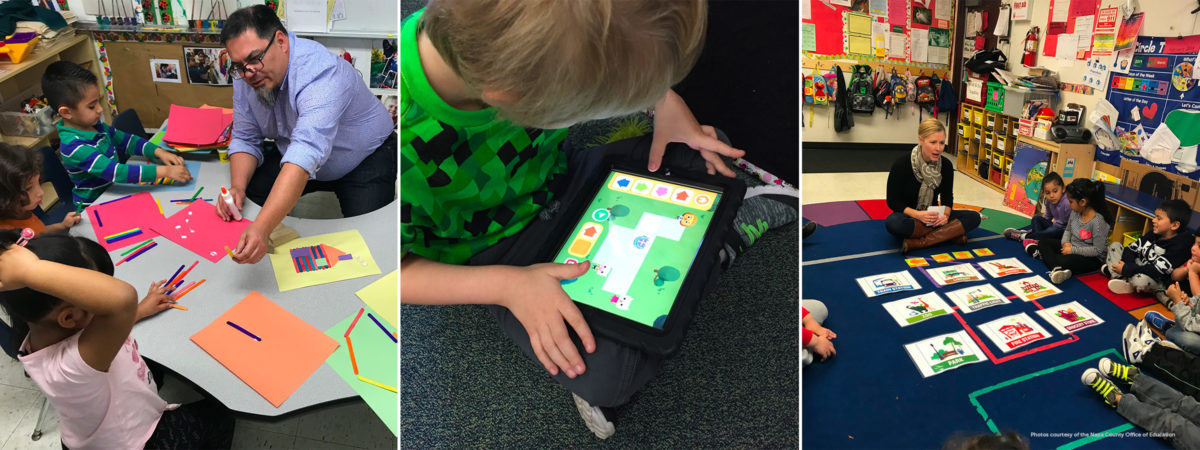
November 17, 2020 | By Ximena Dominguez, Danae Kamdar, Shuchi Grover, Phil Vahey and Phil Balisciano
Through our collaborative design and research process, we developed activities that are developmentally appropriate and easy for teachers and parents to do with children in the classroom and at home. This included the creation of a new, free app, STEM-tastic Adventures (available through the App Store and Google Play), to provide young children fun and engaging opportunities to learn CT and STEM. Keep reading to find out more about the design and research activities that informed the making of the app and other CT learning activities for preschoolers.
Our team brought together public preschool teachers; families from culturally diverse, low-income communities; curriculum and media designers; and researchers. As part of the co-design process, all stakeholders were asked to (1) share their unique perspectives and insights, (2) brainstorm whether and which CT skills could be consequential for early learning, and (3) collaboratively develop (and test) activities and digital apps that explore linking CT with mathematics and science in symbiotic ways.
Through this work together, we aimed to identify learning experiences that resonate with families and children. The goal was to capitalize on children’s and families’ funds of knowledge and identify activities that could bridge home and school learning.

Co-designing STEM resources with teachers and parents
We observed that key elements of emerging CT definitions align with the broader learning goals of early childhood programs, such as children learning to use reasoning and planning ahead to solve problems. Our collaborative team identified the following CT skills as promising for supporting early learning:
Emerging evidence with older children indicates that CT is best learned within disciplinary content, such as math and science, and that STEM learning can be strengthened by integrating CT elements. As we explored whether and how to promote CT with preschoolers, we designed and tested prototype activities that embedded CT into math and science lessons.
For instance, math activities that focused on visual spatial skills (including vocabulary such as forward, backward, left, right) were great opportunities to promote algorithmic thinking (e.g., creating and following a sequence of instructions to get from point A to point B) and debugging.
While we found robust connections between CT and math concepts, connections to science were not specifically tied to core ideas but rather to some components of science practices. For instance, abstraction was promoted while children engaged in science practices that involved observing and sorting. Children observed and discussed properties of food items and sorted them into groups. In dramatic play activities they pretended to build their own grocery store and generated shorthand labels that described the food groups highlighting only necessary details.
The new STEM-tastic Adventures app was developed to help young children practice and learn CT skills in the context of the STEM connections we identified. It currently includes two games: “City Walk” and “Better Building.” The “City Walk” game invites children to create a sequence of navigation instructions for their robot friend to deliver gifts around town. The app scaffolds this process by progressively introducing more complex tasks and helping children learn how to identify errors via visuals and audio feedback. In addition to “City Walk,” children can play “Better Building,” where children sort and label groups of blocks to help the robot more efficiently build structures.

Screenshot of the “City Walk” game in the new STEM-tastic Adventure app

Screenshot of the “Better Building” game in the new STEM-tastic Adventure app
The app is designed to deepen and extend hands-on learning experiences. Most available CT apps focus on coding but they don’t necessarily link to other areas of learning, and few provide scaffolding for young learners. The team hopes to extend the STEM-tastic Adventures app by adding new experiences for young learners to experience CT skills beyond programming.
Interested in downloading this free app? You can find STEM-tastic Adventures in the App Store and on Google Play platforms.
Want to learn even more about our work with CT and early learners? Check out this short video from the 2020 STEM for All Video Showcase.
By Elliott Barnes and Sara Mungall